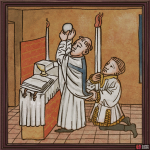Text
Christianity was adopted in the Czech lands in the 10th century, though certain pagan practices continued, especially in rural areas, where they blended naturally with the emerging Christianity. Some of the folk customs were later modified according to Church instructions, others continued unchanged, and yet others were eradicated completely under Church pressure.
In addition to a deep faith in saintly patronage: the saints Wenceslas, Vitus, Nicholas, Ludmilla, Adalbert etc., the Middle Ages revered the Virgin Mary and the various patron saints of professions.
Manifestations of medieval piety consisted of wayside shrines, conciliation stones or crosses, put up in large numbers in villages, at intersections and along the main byways.
In Royal cities and liege towns it was important to collect holy relics, remains and memorabilia to mark the saints. The cult of saints was encouraged, and cathedrals and churches gained prestige with the relics they held. (It need not be emphasized that most of the relics were fakes, and that nobody took much issue with it.)
Devotion was shown in everyday life and accompanied everyone from the cradle to the grave by way of Church rituals, occasions for worship, religious holidays or regulations (for example, the numerous fasts or Lenten days). In some way or other, everyone believed in God; Complete atheism is a matter of later centuries.


No Comments